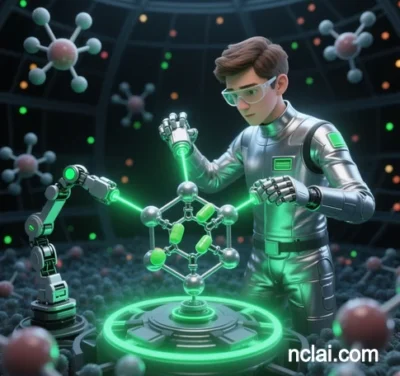
NCL-AI Technology: Definition and Principles of Nano-Carrier-Loaded Artificial Intelligence
Definition
NCL-AI Technology (Nano-Carrier-Loaded Artificial Intelligence) is an interdisciplinary paradigm that integrates nanoparticle drug delivery systems with AI-driven optimization, addressing limitations in biocompatibility, precision targeting, and dynamic responsiveness of traditional drug delivery. Its core objective is to achieve dynamic synergy among nanocarriers, biological microenvironments, and therapeutic targets through data-driven modeling and automated experimental design .
Technical Principles
1. Data-Driven Nanocarrier Design
- Multimodal Data Integration:
AI synthesizes preclinical data (e.g., in vitro cell assays, animal models), clinical data (patient genomics, metabolomics), and material databases (nanocarrier physicochemical properties) to construct multidimensional correlation maps. Machine learning models analyze nonlinear relationships between nanocarrier size, surface charge, drug-loading efficiency, and tumor penetration depth . - Predictive Modeling:
Deep learning (e.g., convolutional neural networks) predicts nanocarrier behavior in biological environments, including blood-brain barrier penetration, immune evasion, and stimulus-responsive drug release (e.g., pH/enzyme-triggered mechanisms) .
2. Intelligent Optimization & Automated Experimentation
- Hybrid AI Tools:
Genetic algorithms (GA), fuzzy logic, and reinforcement learning (RL) optimize nanocarrier formulations. Examples:- Surface Functionalization: Artificial neural networks (ANN) screen ligand modification strategies (e.g., >85% mannose functionalization efficiency) .
- Dynamic Parameter Tuning: AI adjusts synthesis parameters (lipid phase transition temperature, emulsification rates) in real time to ensure uniform particle size (<100 nm) and stability (Zeta potential >20 mV) .
- Self-Driving Laboratories (SDL):
Robotic platforms and high-throughput experimentation, coupled with AI feedback loops, reduce nanocarrier development cycles from months to weeks .
3. Dynamic Responsiveness & Personalized Therapy
- Stimulus-Responsive Design:
AI models tumor microenvironment features (hypoxia, high ATP concentrations) to guide synthesis of environment-sensitive nanocarriers. Examples:- Enzyme-Triggered Release: Matrix metalloproteinase (MMP)-responsive liposomes for lesion-specific drug delivery .
- Photothermal Synergy: Gold nanorods optimized for near-infrared light-activated hyperthermia and chemotherapy co-delivery .
- Patient-Specific Adaptation:
Federated learning aggregates multicenter data to generate personalized nanocarrier strategies (e.g., ovarian cancer subtype-specific targeting) .
4. Multiscale Modeling & Simulation
- Molecular-to-Organ Modeling:
Graph neural networks (GNN) simulate nanocarrier journeys from bloodstream circulation to cellular uptake, quantifying efficiency gains (e.g., 2.3x blood-brain barrier penetration for polymer-based glioma targeting) . - Quantum Computing:
Quantum annealing algorithms optimize nanocarrier topology, overcoming combinatorial explosions in lipid molecular energy state optimization .
Core Applications
| Domain | AI-Driven Innovation | Case Study & Efficacy |
|---|---|---|
| Cancer Therapy | Ligand-receptor matching optimization | Mannose-modified carriers achieve >85% macrophage targeting efficiency |
| Neurological Disorders | Enhanced blood-brain barrier penetration | Polymer nanocarriers increase brain drug concentration by 4x |
| Inflammatory Diseases | Dynamic immune modulation | pH-responsive carriers reduce systemic toxicity by 50% in arthritis models |
| Regenerative Medicine | Stem cell delivery protection | Nanogel encapsulation improves stem cell survival by 70% |
Challenges & Future Directions
- Data Integration Barriers:
Heterogeneity between preclinical and clinical data (e.g., animal-human discrepancies) necessitates transfer learning frameworks to enhance model generalizability . - Explainability Gaps:
“Black-box” AI decisions (e.g., nanocarrier toxicity mechanisms) require causal inference models for transparency . - Ethical & Regulatory Hurdles:
Standardized protocols for AI-driven GMP production of nanocarriers remain underdeveloped . - Frontier Innovations:
- Living Nanorobots: AI-designed self-propelled microrobots for intravascular navigation and lesion repair (planned for 2026 trials) .
- Brain-Computer Interface (BCI) Integration: Closed-loop systems linking nanocarriers to neural signal modulation .
Conclusion
NCL-AI redefines nanocarrier development through a data-algorithm-experiment triad, shifting paradigms from empirical to model-driven, static to dynamic, and broad-spectrum to precision medicine. By elevating nanocarriers to “molecular machine” sophistication, it offers transformative solutions for cancer, neurodegeneration, and beyond.
Data sourced from public references. For collaborations or domain inquiries, contact: chuanchuan810@gmail.com.
